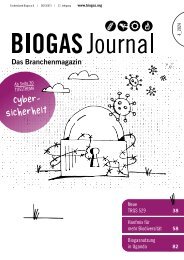Create successful ePaper yourself
Turn your PDF publications into a flip-book with our unique Google optimized e-Paper software.
Feeds<strong>to</strong>ck preparation<br />
5 Feeds<strong>to</strong>ck preparation<br />
In order <strong>to</strong> prevent malfunctions in the digestion process and produce<br />
high-quality digestate or compost, materials like plastics, glass, paper,<br />
metals, s<strong>to</strong>nes or oversized components must be removed. To do this,<br />
liquid as well as dry removal of impurities can be improved prior, during<br />
or after the digestion process in efficient disintegration, preparation and<br />
separation stages.<br />
Waste lorry is<br />
unloading biowaste<br />
in<strong>to</strong> the bunker<br />
The quality of input material is of the utmost importance,<br />
especially if the intention is <strong>to</strong> use the produced<br />
fertilizer in agriculture, horticulture or landscaping. It<br />
is essential <strong>to</strong> prepare an optimal feeds<strong>to</strong>ck mixture, <strong>to</strong><br />
ensure operating conditions remain stable, <strong>to</strong> obtain<br />
the best possible biogas yields and <strong>to</strong> maintain the intended<br />
lifespan of the equipment and machinery. Clean<br />
feeds<strong>to</strong>ck from controlled sources, such as industry or<br />
agriculture, is therefore optimal for the biogas process<br />
and the quality of the digestate and compost produced.<br />
Other biowaste is not always free of non-biodegradable<br />
or unsuitable materials and contaminants. Expired food<br />
from supermarkets, for example, might still be packaged<br />
in glass, plastic or cardboard containers. Catering<br />
waste might contain cutlery or bones. As explained in<br />
the previous chapter, source-separated biowaste from<br />
households can be a particularly challenging feeds<strong>to</strong>ck,<br />
because its purity depends on the motivation of individuals<br />
<strong>to</strong> properly separate waste at source and not throw<br />
inorganic materials (such as batteries or yoghurt pots)<br />
in<strong>to</strong> biowaste bins. The quality of this kind of biowaste,<br />
therefore, varies considerably according <strong>to</strong> a number of<br />
fac<strong>to</strong>rs including social structure, education, location<br />
(rural or urban) and population density. Hence, public<br />
education and a control of waste bins is the first step <strong>to</strong><br />
control the quality of collected biowaste. Nevertheless,<br />
Liquid removal<br />
of impurities<br />
Disintegration and<br />
unpacking technologies<br />
Dry removal<br />
of impurities<br />
there will always be environmentally conscious people<br />
who will unintentionally throw away objects properly<br />
(e.g. brand-new garden shears), so that controls at the<br />
plants will always be necessary.<br />
For the technical removal of impurities, different solutions<br />
are available depending on the input material, its<br />
consistency and the kind of impurities contained. In<br />
this brochure, the following symbols for disintegration<br />
and unpacking technologies, as well as liquid and dry<br />
removal techniques, are used <strong>to</strong> facilitate the identification<br />
of relevant manufacturers of feeds<strong>to</strong>ck preparation<br />
systems in the company direc<strong>to</strong>ry. The removal<br />
of impurities might happen before, during or after the<br />
biological biogas process.<br />
The efficiency of every method depends on technical<br />
equipment, energy consumption and the share of impurities<br />
separated. Together with the removed impurities,<br />
organic compounds are also separated, which have <strong>to</strong><br />
be disposed of (for example by incineration) and are<br />
not used for biogas and digestate production anymore.<br />
But even MSW can be prepared <strong>to</strong> generate a suitable<br />
feeds<strong>to</strong>ck for anaerobic digestion as also demonstrated<br />
in the reference plants, even if the use of the produced<br />
digestate and compost is legally not allowed in every<br />
country.<br />
The first stage in the preparation process usually<br />
involves disintegration and unpacking<br />
technologies. The aim is <strong>to</strong> reduce particle size, <strong>to</strong> remove<br />
packaging and <strong>to</strong> generate a more homogenous<br />
material for the digestion process. This can be achieved<br />
by squeezing, cutting, milling or shredding the material.<br />
During disintegration, light material like plastics can<br />
be blown out. Presses and paddles help free the organic<br />
material from packaging by applying pressure or<br />
centrifugal force through a screen. This approach can<br />
16

















